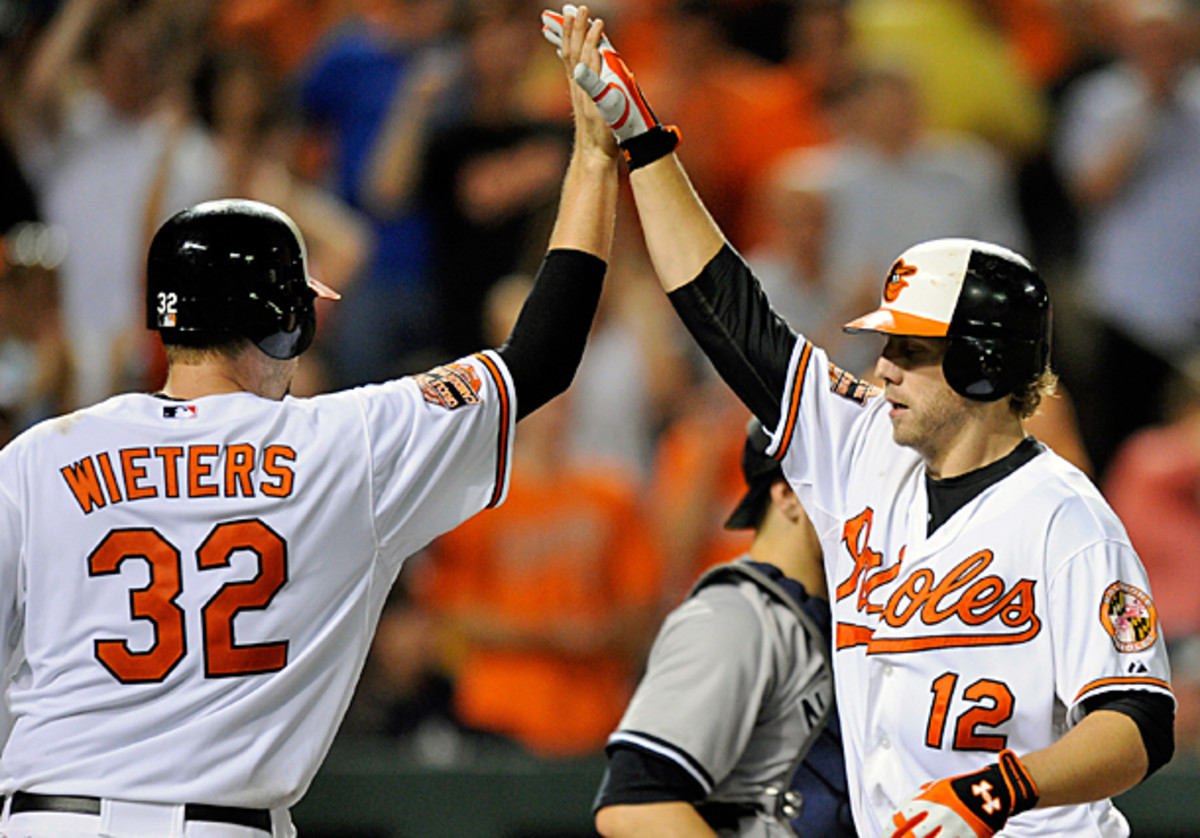Orioles powering their way to legitimacy

Matt Wieters hit a three-run blast and Mark Reynolds (12) added two more for the red-hot Orioles. (Nick Wass/AP)

For the second time in the last three days, the Orioles have moved into a tie with the Yankees atop the American League East. On Tuesday, they did it by stomping the Blue Jays 12-0 while the Yankees lost to the Rays. Thursday night, they did it by stomping the Yankees directly, beating them 10-6 in a game that saw the Yankees stage a five-run eighth-inning rally to tie the game at 6-6 only to give up four runs on a trio of home runs in the bottom of the inning. In total, the Orioles hit a season-high six home runs, with all but one of their ten runs scoring on the long ball. For the third time in the last seven days, and the third time in their last three wins against the Yanks, Orioles first baseman Mark Reynolds went deep twice.
With Thursday night's win, the Orioles have now gone 25-11 (.694) since July 29, outscoring their opponents 181-135, a run differential that translates to a .643 winning percentage using Bill James' Pythagorean formula. Whatever magic the Orioles may have been using prior to that (when they were three games over .500 despite being outscored by 63 runs and owning a .430 Pythagorean winning percentage), it has given way to an Orioles team that, at least over those last 36 games, is very much for real.
What we saw from the Orioles on Thursday night was the manifestation of some of that. Those six home runs, for example, moved the Orioles past the idle Blue Jays and White Sox into second place in the majors with 176 taters, only the Yankees have more, with 204. Reynolds' two home runs gave him 20, Matt Wieters' three-run shot off David Phelps in the first gave him 19, Adam Jones' tie-breaking solo blast leading off the bottom of the eighth was his team-leading 28th, and Chris Davis' add-on shot off fellow lefty Boone Logan later that inning was his 25th. Only Robert Andino's solo home run in the fourth, his career-high sixth of the season, was out of character.
With J.J. Hardy at 18 home runs, the Orioles seem likely to finish the season with five men having hit 20 or more home runs and seven in double-digits, adding Nick Markakis (13) and Wilson Betemit (12). By way of comparison, the American League record for most players on a team with 20 home runs in a season is seven, and the National League record is six. The 1961 Yankees, whose team record of 240 homers stood for 35 years, had six men with 20 or more and seven men in double-digits.
As for Reynolds, over the course of the last week alone, he became just the second player ever to have three multi-homer games against the Yankees in a single season, joining Hall of Famer Hank Greenberg, who did it over four months in 1938. Yet, Reynolds' hot hitting this season isn't confined to games against the Yankees in September. In 27 games dating back to August 6, Reynolds is hitting .333/.444/.789 with 12 homers -- half of which didn't come against the Yankees this week -- and 26 RBIs. He won't keep that up, of course, but he had hit just six home runs in the season's first four months after averaging more than 37 over the last three seasons, which seems every bit as fluky.
With all of those balls leaving the park, I've barely had time to mention Jason Hammel's strong return to the mound. Hammel was the Orioles' best starter in the first half of the season, going 8-2 with a 2.61 ERA in his first 14 starts before hitting a rough patch that one could attribute to the loose body in his right knee that required surgery in mid-July. Thursday night, he returned to action and looked sharp, holding the Yankees to one run over five innings while striking out six. Hammel threw first-pitch strikes to 18 of 22 batters, his fastball sat around 93 miles per hour, spiking to 94, and his curve was sharp, serving as the out-pitch on the majority of those strikeouts, including a three-pitch K of Robinson Cano with two out and two on in the biggest at-bat of his outing. He only came out after five innings and 82 pitches because he'd been on the shelf for four weeks (he made just one rehab start, also lasting five innings) and had walked two of his last three batters, his only walks of the game.
The return of Hammel strengthens a unit that has been key to the Orioles' surge over the last month: the starting rotation. Including Hammel's start on Thursday, the Orioles' starters have posted a 3.68 ERA in the team's last 32 games dating back to August 3. By way of comparison, the second-best rotation in the league, that of the A's, who play in a pitching-friendly ballpark, has posted a 3.77 ERA over the entire season.
Cliff Corcoran
